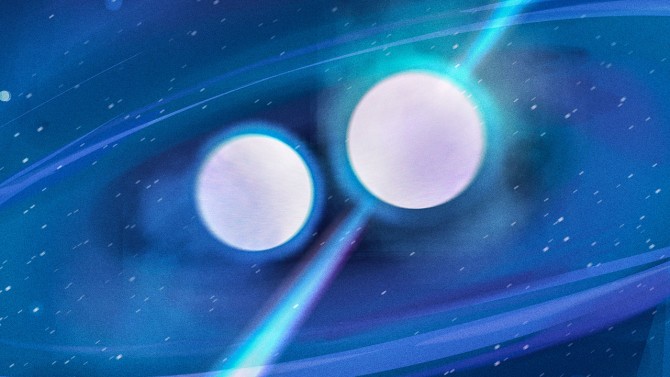Milky Way neutron star pair illuminates cosmic cataclysms
By Blaine Friedlander
A pair of binary neutron stars in the Milky Way galaxy – discovered eight years ago by a pulsar survey developed at Cornell – is giving researchers a front-row seat at what they believe will be the stars’ eventual cataclysmic merger.
Two Cornell astronomers with an international team of scientists have found that the masses of the neutron stars orbiting each other are strikingly different – so that when they eventually merge, their two masses will produce more ejecta than otherwise expected.
The merger will be similar to the famous 2017 neutron star event, named GW170817, that produced the first observed gravitational waves and light – and featured a flurry of electromagnetic phenomena.
In other words, the binary neutron stars in the Milky Way provide a close-to-home model to understand the 2017 event.
“The connection is that we’re getting a chance to see this kind of binary in its baby stages,” said James Cordes, the George Feldstein Professor of Astronomy in the College of Arts and Sciences and co-author of a study on the discovery. “Observe locally and understand from afar.”
The team’s work was published July 8 in Nature.
In the study, radio astronomers measured the masses of the two neutron stars in the binary neutron star, named PSR J1913+1102, and concluded that they were asymmetric, Cordes said.
As a result, the astronomers believe that when this binary neutron star merges in about a half-billion years, violent tidal forces will shred the neutron stars and eject a lot of material as it emits gravitational waves.
They’re basing that hypothesis on the August 2017 event, when the LIGO and Virgo detectors observed gravitational waves visually and by radio telescope that were 130 million light-years away. In the final throes of merging, two neutron stars had emitted copious gravitation waves.
“That merger event detected in 2017 was a Rosetta stone for ‘multi-messenger’ astronomy, which includes standard observations in the gamma rays, X-rays, and optical and radio bands combined with gravitational waves,” said Cordes. “The cataclysmic event featured more ejecta than expected, allowing the detailed study.”
For radio astronomers, examining the binary neutron star is a professional treat.
“We’re watching the whole binary evolution process long before the merger happens,” said co-author Shami Chatterjee, senior research associate in astronomy. “This gives us a front-row seat right in our own Milky Way neighborhood.”
The fast-spinning binary neutron star was discovered in 2012 by the Pulsar Arecibo L-band Feed Array (PALFA), survey at the radio telescope at Arecibo Observatory, Puerto Rico. Cordes started PALFA in 2004, and Cornell manages the PALFA data through the university’s Center for Advanced Computing.
The larger neutron star is 1.62 times the mass of our own sun, but all that mass fits tightly into a ball the size of a city, according to the astronomers. The smaller star is about 1.27 times the mass of the sun.
“Seeing PSR J1913+1102 allows astronomers to calculate what neutron star mergers should look like if the masses are asymmetrical,” Chatterjee said. “We can detect the gravitational waves, spot the neutron stars and know what we’re looking for in other galaxies.”
The lead authors of the paper, “Asymmetric Mass Ratios for Bright Double Neutron-Star Mergers,” are Robert. D. Ferdman, University of East Anglia, Norwich, England; Paulo Freire, Max Planck Institute for Radio Astronomy, Bonn, Germany; Benetge Perera, Arecibo Observatory; and Nihan Pol from West Virginia University.
The National Science Foundation funded the Cornell portion of the research.
Media Contact
Get Cornell news delivered right to your inbox.
Subscribe

